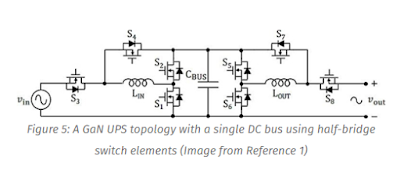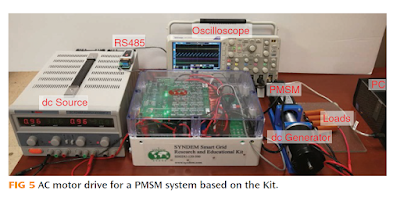Enter a GaN soft-switching transformer-less online UPS topology which enables significant size reduction by operating efficiently at high switching frequencies using GaN power devices. See Figure 5, at right.
The proposed UPS employs standard GaN half-bridge structures with a common-neutral between the input and output and is able to achieve zero-voltage switching (ZVS) operation, in the boundary conduction mode, with no additional complex circuit design. This design employs a new control methodology for the UPS that has a dual-mode digital controller for the input PFC rectifier stage. The digital controller regulates the output voltage of the converter across both resistive and reactive loads.
The inverter (DC/AC) stage is also operated in dual-mode, and a digital controller regulates the output voltage of the converter across resistive and reactive loads. This converter architecture is capable of delivering 1-kVA of output power while maintaining unity power factor at its input. This GaN-based 1-kVA online UPS is operated using the proposed control technique in Reference 1, and is designed, built, and tested. The prototype UPS, operated up to 2MHz, achieved a power density of 26.4W/in3.
References
1-Control of a GaN-Based High-Power-Density Single-Phase Online Uninterruptible Power Supply, Danish Shahzad, Saad Pervaiz, Nauman Zaffar, Khurram K. Afridi, IEEE 2019
2- Performance Comparison of 1200V Silicon and SiC devices for UPS Application, James McBryde, Arun Kadavelugu, Bobby Compton, Subhashish Bhattacharya, Mrinal Das, Anant Agarwal, IEEE 2010
LINK ORIGINAL:https://gan-sic-power.richardsonrfpd.com/applications/application-industrial-ups/
















































 JOSIL ARTISTA PLASTICO FORTALEZA CEARA BRASIL AV.HERACLITO GRAÇA 41 TEL(85)32542378
JOSIL ARTISTA PLASTICO FORTALEZA CEARA BRASIL AV.HERACLITO GRAÇA 41 TEL(85)32542378
















